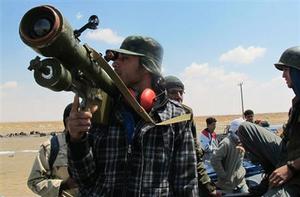TerrorismAl Qaeda-affiliated militants training in using shoulder-fired anti-aircraft missile
A Xerox copy of a 26-page manual with instructions on how to use man-portable air-defense systems, or MANPADS – also called SA-7 — was found in a building in Timbuktu in North Mali which was used by Al Qaeda in the Islamic Maghreb operatives during the 8-month control – April 2012 to February 2013 — of the area by Islamist militants. The Libyan military under Col. Qaddafi had about 15,000 SA-7s, but after the Qaddafi regime fell in November 2011, NATO forces and Libyan militias loyal to the government gained possession of only 5,000 of them. The rest have disappeared into the arsenals of different militias, and have probably found their way to different terrorist organizations in North Africa and the Middle East.

Stinger-type missiles have found their way from Libya to al Qaeda // Source: baomoi.com
A Xerox copy of a 26-page manual with instructions on how to use man-portable air-defense systems, or MANPADS – also called SA-7 — was found in a building in Timbuktu in North Mali which was used by Al Qaeda in the Islamic Maghreb operatives during the 8-month control – April 2012 to February 2013 — of the area by Islamist militants. Fox News reports that the Associated Press obtained a copy of the manual for the SA-7.
These shoulder-fired missiles, capable of bringing down both civilian and military aircraft have long been a concern for U.S. and other governments.
The Libyan military under Col. Qaddafi had about 15,000 SA-7s, but after the Qaddafi regime fell in November 2011, NATO forces and Libyan militias loyal to the government gained possession of only 5,000 of them. The rest have disappeared into the arsenals of different militias, and have probably found their way to different terrorist organizations in North Africa and the Middle East.
“The existence of what apparently constitutes a ‘Dummies Guide to MANPADS’ is strong circumstantial evidence of Al Qaeda in the Islamic Maghreb having the missiles,” Atlantic Council analyst Peter Pham, a former adviser to the U.S. military command in Africa and an instructor to U.S. Special Forces, told Fox News. “Why else bother to write the guide if you don’t have the weapons? … If AQIM not only has the MANPADS, but also fighters who know how to use them effectively,” he added, “then the impact is significant, not only on the current conflict, but on security throughout North and West Africa, and possibly beyond.”
Six months before Qaddafi was toppled, teams of U.S. specialists flew to Libya to secure the Libyan arsenal of these heat-seeking missiles in military bases abandoned by the retreating Libyan military. By the time the teams arrived, most of the missiles had already disappeared.
“The MANPADS were specifically being sought out,” Peter Bouckaert, emergencies director for Human Rights Watch, told Fox News. Bouckaert catalogued missing weapons at dozens of Libyan depots and sayd he often found boxes labeled with the code for surface-to-air missiles empty.
French forces, dispatched to Mali in January, found SA-7 battery pack and launch tube in Timbuktu.
The SA-7 cost about $5,000.
The U.S. Department of State says that since 1975, at least forty civilian aircraft have been hit by different types of MANPADS, resulting in twenty-eight crashes and more than 800 deaths around the world.
In 2002, al Qaeda fighters in Kenya fired two SA-7s at a Boeing 757 carrying 271 Israelis from a vacation back to Israel, but missed.
Bruce Hoffman, director of the Center for Security Studies at Georgetown University says the failure of the Islamists in Mali so far to hit a plane could mean that they cannot position themselves near airports with commercial flights, or that they are not yet well-trained enough to use the missile.
“This is not a ‘Fire and forget’ weapon,” he said. “There’s a paradox here. One the one hand it’s not easy to use, but against any commercial aircraft there would be no defenses against them. It’s impossible to protect against it. … If terrorists start training and learn how to use them, we’ll be in a lot of trouble.”
N.R. Jenzen-Jones, an arms expert in Australia, agrees, noting that the history of the SA-7 is one of near-misses, specifically because it takes training to use.
“Even if you get your hands on an SA-7, it’s no guarantee of success,” he told Fox News. “However, if someone manages to take down a civilian aircraft, it’s hundreds of dead instantly. It’s a high impact, low-frequency event, and it sows a lot of fear.”
